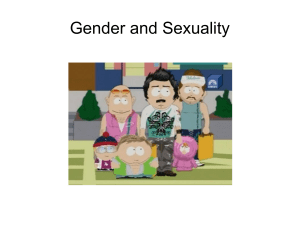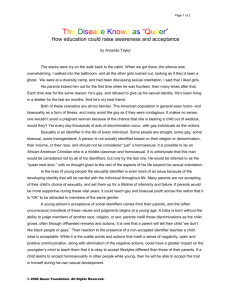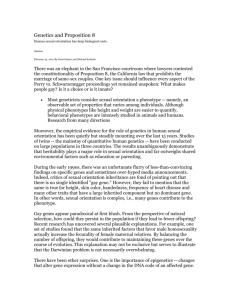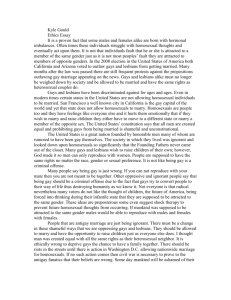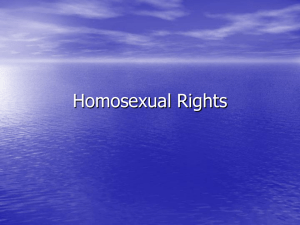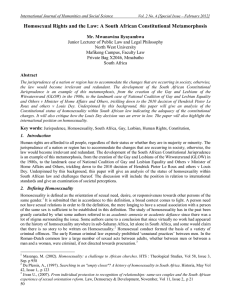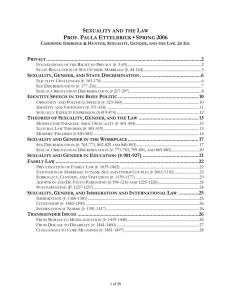RightsRevolutionsPart1
advertisement
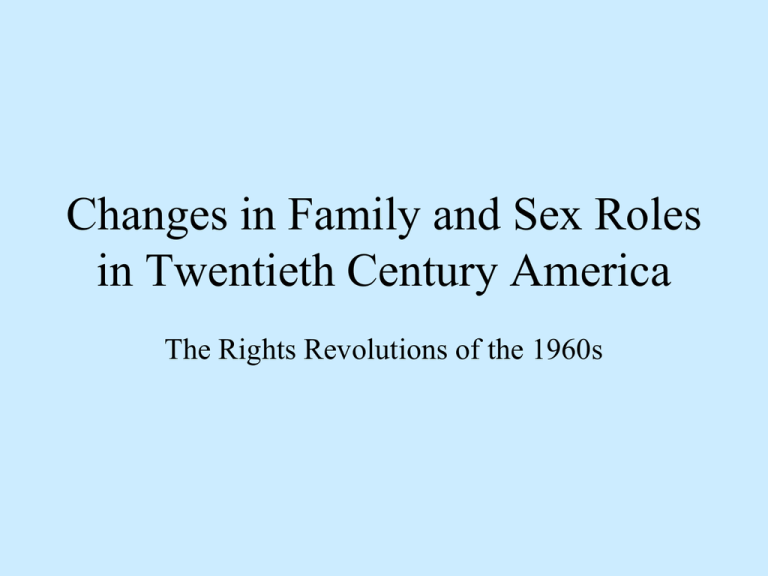
Changes in Family and Sex Roles in Twentieth Century America The Rights Revolutions of the 1960s The Challenges…. • To White Supremacy – Civil Rights • To Patriarchy -- Second Wage Feminism • To Sexual Orthodoxy – Sexual Revolution and Gay Rights Civil Rights Movement • 1940s-1950s: NAACP, Urban League, Southern Christian Leadership Conference, attack the “separate but equal” doctrine in American law and social practice. – 1954: Brown v Bd of Ed overturns Plessy v Ferguson – Rosa Parks refused to move to the back of the bus and starts a movement of nonviolent civil disobedience. Civil Rights Movement Goals • Integration of institutions of public and economic life • Equality of opportunity for all Americans • End of theories of racial inferiority and white superiority • …. • Principles of “rights talk” expands to other avenues of life…. Civil Rights Legal and Legislative Changes • First the courts: Brown v. Board of Education (1954) desegregated public schools. – Repudiated the theory of “separate but equal” • Equal Pay Act of 1963: – Men and women must be paid the same for the same jobs. • Civil Rights Act of 1964 – Nondiscrimination in public accommodations – Title VII: Nondiscrimination in the labor market • Voting Rights Act of 1965 • Housing Act of 1968 – non discrimination required in housing markets Second Wave Feminism • Challenges the patriarchal family • Challenges the sexual control of women • Challenges roles of masculinity and femininity and women’s place in society The Baby Boom Sexual Revolution of the 1960s and its Legacy • “Playboy” culture for men and…. • Birth control pill for reliable contraception for women • Lead to new possibilities for and debates about gender relations…. Second Wave Feminism • Betty Friedan’s The Feminine Mystique (1963) signaled new challenges to the limitations on women’s roles • New organizations appeared: – National Organization for Women (NOW) (1966) – Women’s liberation and consciousness raising groups – late 1960s and later Betty Friedan and Gloria Steinem Sexual Revolution of the 1960s and its Legacy: Gay Rights Same Sex Relations • We have examined the history of sexuality primarily in the context of the history of the family. • Western religious traditions conceptualize same sex sexual relations as deviant and/or sinful, and classify same sex physical relations with other forms of deviant, sinful, or prohibited sexuality (e.g., fornication, adultery, bestiality, masturbation). • The logic behind such a conception is that the purpose of sexuality is procreation, and such behavior is not potentially procreative. Movements for Sexual Liberation • Come from a variety of interests, e.g.,…. – Heterosexual Men and Women – Science and Medicine – Gays and Lesbians Science and Medicine... • Challenge the authority of law and religious authorities to define the “normal” and the “deviant” in sexuality. – Psychologists: Freud – Sociologists • Alfred Kinsey – Physiologists • Masters and Johnson Sociologists... • ...begin to survey sexual practices. • The Kinsey Reports of the 1940s and 1950s demonstrated the discrepancy between morality and practice • For example, 1/3rd of men acknowledged a sexual relationship to orgasm with another male Physiologists... • Masters and Johnson conducted ‘experiments’ to study human sexuality by putting people in a laboratory, wiring them up and recording physiological responses. • When: 1950s and 1960s Gays and Lesbians…. • And the the right to sexual autonomy. • In the US, cities developed gay and lesbian subcultures (turn of the 20th century), including bars and restaurants, and networks of jobs and relationships of support. • These communities were periodically harassed and prosecuted under local vice laws. Gay Rights Organizations 1924 The Society for Human Rights in Chicago becomes the country's earliest known gay rights organization. 1951 The Mattachine Society, the first national gay rights organization, is formed by Harry Hay, considered by many to be the founder of the gay rights movement. 1956 The Daughters of Bilitis, a pioneering national lesbian organization, is founded. Gays and Lesbians... • In 1969, at the Stonewall Inn, a bar in Greenwich Village, NY, the patrons fought back when the police attempted to raid the bar and arrest patrons. A street riot broke out and led to an open movement for the rights of gays and lesbians, patterned on the civil rights and women’s liberation movements. Stonewall Inn Making Gay Culture Visible Changes... 1973 The American Psychiatric Association removed homosexuality from its official list of mental disorders. 1982 Wisconsin became the first state to outlaw discrimination on the basis of sexual orientation. 1980s AIDS Epidemic 1993 The “Don't Ask, Don't Tell” policy was instituted for the U.S. military, permitting gays to serve in the military but banning homosexual activity. President Clinton's original intention to revoke the prohibition against gays in the military was met with stiff opposition; this compromise, which has led to the discharge of thousands of men and women in the armed forces, was the result. 1996 In Romer v. Evans, the Supreme Court strikes down Colorado's Amendment 2, which denied gays and lesbians protections against discrimination, calling them “special rights.” According to Justice Anthony Kennedy, “We find nothing special in the protections Amendment 2 withholds. These protections . . . constitute ordinary civil life in a free society.” Changes... 2000 Vermont became the first state in the country to legally recognize civil unions between gay or lesbian couples. The law stated that these “couples would be entitled to the same benefits, privileges, and responsibilities as spouses.” It stopped short of referring to same-sex unions as marriage, which the state defined as heterosexual.1 2003 The U.S. Supreme Court ruled that sodomy laws in the U.S. are unconstitutional. Justice Anthony Kennedy wrote, “Liberty presumes an autonomy of self that includes freedom of thought, belief, expression, and certain intimate conduct.” • In November, the Massachusetts Supreme Judicial Court ruled that barring gays and lesbians from marrying violated the state constitution. The Massachusetts Chief Justice concluded that to “deny the protections, benefits, and obligations conferred by civil marriage” to gay couples was unconstitutional because it denied “the dignity and equality of all individuals” and made them “second-class citizens.” Strong opposition followed the ruling. 2004 On May 17, same-sex marriages became legal in Massachusetts. 2005 Civil unions became legal in Connecticut in Oct. 2005. Wisconsin in 2006 • Should the State Constitution ban same sex marriage? • The November Ballot • Pro • And • Con • The amendment passed, November 2006 Same Sex Marriage: A Contested Issue? • US Defense of Marriage Act (1996) defines marriage as a union of one man and one woman. • Obama administration is currently refusing to enforce it or defend it in court • Same sex marriage is legal in CT, IA, MA, NH, NY, NT, DC. Partially recognized in other states. Same Sex Households • How many are there? • The 2010 census provides reports for the first time: – 131,729 same-sex married couple households and 514,735 same-sex unmarried partner households in the United States. Later Developments • Griswold v. Connecticut (1965), provided constitutional protection for birth control and articulated a right to privacy – Struck down CT law making contraception illegal for married couples. • Roe v. Wade (1973): Legalized abortion – Defended by “pro choice movement” to define the right to “choose” – Attacked by “pro life movement” on the grounds that abortion takes the life of a fetus. • Sexual Harassment defined as illegal form of discrimination by courts in late 1970s. Challenges to Patriarchal Social Relations • Equal Rights Amendment: But it fails in late 1970s • Gender Gap in voting since 1980 – Women and men vote differently • Changes in family structure: – dual earner family – single parent family – same sex marriage If the Past is Prologue….. • Will Congress repeal “Don’t Ask, Don’t Tell? • Will the Supreme Court declare the Patient Protection and Affordable Care Act unconstitutional? • How many “same sex marriages” will be counted in the 2010 Census? • Will there be a woman president in 2012, 2016, or 2020 And in your lives…. • How have family and sex roles changed in your lives? • How will they change in the future? • Thank you • Take more History and Women’s Studies courses to continue the conversations! Remaining Issues… • Health Care and Insurance? • Support for Job Training and Higher Education? • Food Security? Additional Provisions • Food Stamps: 1964 – Locally administered program providing means tested support – Also supported by farming interests • Medicare and Medicaid: 1965 – National Health Insurance for Elderly – Health Insurance for the indigent administered locally. • Higher Education Aid: – GI Bill of Rights, post World War II, subsidized education for veterans – National Defense Education Act (1950 and 1960s) began grant and loan programs for higher education. Has the Welfare State Accomplished its Goals? Should it Continue? • Debate begins in the 1970s: – The Welfare State has guaranteed Americans the highest living standards in the world…. – Or… – The Welfare State has outlived its usefulness, taxes are too high, and once again families and the private sector should shoulder the burden of care. Examples of the New Understanding • 1994: The Clinton Administration’s proposals for national health insurance collapsed, and Americans elected a Republican Congress for the first time in 60 years. • 1996: Congress repealed Aid to Families with Dependent Children, one of the original provisions of the 1935 Social Security Act. – PRWORA: Personal Responsibility and Work Opportunities Reconciliation Act • Bush administration proposed privatizing the BOASI system in 2005 but no further action taken. National Health Reform • Patient Protection and Affordable Care Act, passed, March 2009 – End to denial of coverage for pre existing conditions – End to limits on coverage – Insurers cannot cancel coverage – Mandated coverage and “Health Exchanges” created for individuals without employer access to health insurance National Health Reform • Patient Protection and Affordable Care Act, passed, March 2009 • Provisions phased in over a number of years • But law is controversial and being challenges in court • Current prognosis is unclear…. Contemporary Issues in Family and Sex Roles What’s next….?
